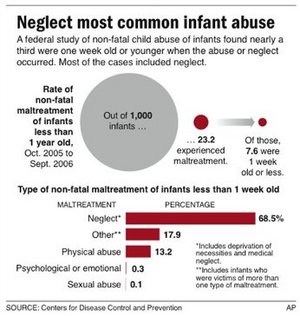
|
| ©Unknown |
| Graphic shows rate and type of non-fatal maltreatment in children younger than one year old; 2c x 4 1/4 inches; 96.3 mm x 108 mm |
Most of these cases involved neglect, not physical abuse. In the case of the newborns, experts said the data suggests drug abuse by the mother may have been the cause for reports of neglect, but they couldn't be certain.
Maternal drug abuse is often discovered through blood tests while newborns are still in the hospital, CDC researchers and others said.
"That is the story here," said Dr. Howard Dubowitz, a professor of pediatrics at the University of Maryland School of Medicine.
The researchers counted more than 91,000 infant victims of abuse and neglect during the study period Oct. 1, 2005 to Sept. 30, 2006. About 30,000 of those cases were newborns aged one week or younger.
The information came from a national database of cases verified by protective services agencies in 45 states, the District of Columbia and Puerto Rico.
Other studies have looked at national child abuse and neglect cases, but this is believed to be the first to focus on infants, said study co-author Rebecca Leeb, of the Centers for Disease Control and Prevention.
The results mirror what a study in Canada found, said Leeb, a CDC epidemiologist.
"We certainly were distressed" by the study's results, said Ileana Arias, director of the CDC's National Center for Injury Prevention and Control.
"It's a picture you don't want to imagine - that this number of infants is being mistreated," Arias added.
Only about 13 percent of the newborn cases were counted as physical abuse, meaning the large majority involved neglect. Federal officials define neglect as a failure to meet a child's basic needs, including housing, clothing, feeding and access to medical care.
The counted cases did not include new parents stumbling their way through breast-feeding or making other rookie mistakes.
"Things like abandonment and newborn drug addiction would qualify as neglect, not things like parents learning how to be parents," Leeb said.
Medical professionals identified about 65 percent of the maltreated newborns to protective services staff. The others came from law enforcement, relatives, friends, neighbors and from protective services staff.
The neglect cases include situations in which medical professionals conclude that a child got sick or didn't correctly develop because parents didn't get recommended medical care. Those cases were not necessarily life-threatening, noted David Finkelhor, who directs the Crimes against Children Research Center at the University of New Hampshire.
Finkelhor said the cases might in part reflect families who don't have adequate health insurance. The study's authors said they don't have information to verify that theory.
Both Finkelhor and Dubowitz have worked with the same database the researchers used. But Dubowitz pointed to data showing that most of the neglect cases in newborns were reported in the first two days of life.
That is a time when results from blood tests of mother and child come back and are often shared with protective services. Such tests would indicate whether the mother was abusing drugs.
However, Dubowitz said data on potential explanations behind neglect cases is skimpy, so it is difficult to draw conclusions.
But more prenatal care and drug treatment services would seem like a wise way to address the problem, he added.
The study didn't include data on fatal abuse and neglect. But federal officials said about 500 infants under age 1 died of abuse or neglect during the study period.
The CDC collaborated on the study with the federal Administration for Children and Families. The research was published in the CDC's Morbidity and Mortality Weekly Report.



This is total BS! How menacing was is loud voice to a child barely able to walk even if not specifically directed at said child? I think the figure is somehow backward, maybe the associated press made a mistake and meant 49 of 50? Who isn't damaged in some way whether indirectly or not?
"..more prenatal care and drug treatment services would seem like a wise way to address the problem.."
Yeah just dope'm up some more..teach'm better dissociation by making them an addict of something else. My god what a sick bunch of stuff with more prying instead of the potential of real psychological help, self help or sitting with a therapist. Apologies but what the heaven is up with this Dubowitz, is he in denial of his own flawed upbringing? Sheesh cuts so short of how this article makes me feel about the veils of dung we have to wander through to get some reality from the AP and mainstream media.
My bad, it's not gonna happen.
I can't extract the issue from the world and must admit my own upbringing on one hand and the suffering I've offered others on the other as well. One in 50 are the walking wounded, pure balderdash.
One thing more about trauma victims. At a certain point even abuse can feel like attention, whether good or bad it becomes a need for a form of interaction. Of course this isn't to say this perspective of mine is actual fact in terms of working knowledge or experience, I may be mistaken.